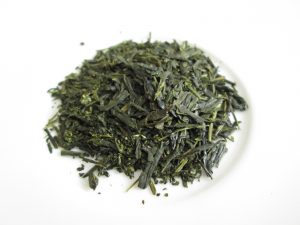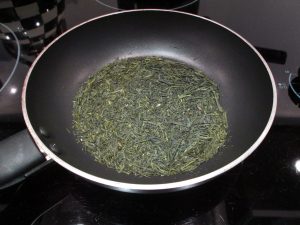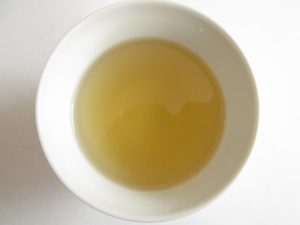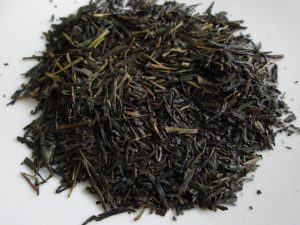 Today I’ll be doing something very uncommon, but curiosity knows no bounds 🙂
Today I’ll be doing something very uncommon, but curiosity knows no bounds 🙂
It all began when I opened a package of gyokuro that was very old, 3 years or more.
It lost all of its original aroma, and the leaves became more brittle so that there’s leaf dust everywhere.
I also found out that the characteristic umami flavor of gyokuro was gone too. Green tea degrades quickly, so by all means drink your high quality green teas first! The fresher the better.
The way I had been brewing it was as a bancha, which was amusing, so I tweeted about it.
Then James from Chanoyu, a teaware store that will open in the UK, suggested the roasting. I’ve roasted sencha and bancha many times (refer to my post about roasting houjicha at home) but roasting gyokuro never crossed my mind!
Since it was already in a bad state, I decided to go ahead and roast it, hoping that the result would be a better tea.
How to make a roasted gyokuro
 I took the leaves and set a pan on low heat. After a few minutes, the kitchen was filled with a roasted aroma.
I took the leaves and set a pan on low heat. After a few minutes, the kitchen was filled with a roasted aroma.
This aroma is very pleasant for me, but I could see that my wife didn’t like it very much, plus we live in a small apartment.
After opening the window, I see that a faint smoke is coming out of the tea leaves. They became darker, with a brown hue to them.
Unfortunately, the gyokuro dust began to burn before the tea leaves could roast a little more. I had to stop there because the flavor would be ruined.
The leaves smelled “fresher” than a normal houjicha. I also filtered out the dust as best as I could.
I brewed it just like I would a houjicha: 30 seconds of steeping time in boiling water.
The liquor has a slight roasted smell and a golden color. It looks very different from the average houjicha.
 Finally, I get to taste it! It is oddly sweet, and just like before it doesn’t taste like gyokuro. It does have a roasted flavor, and there’s no bitterness, just some astringency.
Finally, I get to taste it! It is oddly sweet, and just like before it doesn’t taste like gyokuro. It does have a roasted flavor, and there’s no bitterness, just some astringency.
My opinion is that a commercial houjicha tastes much better than this.
I could try roasting a fresh gyokuro, but it would probably be a waste. First I have to go trough all this old gyokuro that I have just roasted…






October 7, 2014
A very timely post for me, Ricardo.
I ran out of Gyokuro and my kind husband, a coffee drinker, bought me some roast, a large amount.
It has a nice, mellow flavour, but there is nothing of Gyokuro about it, and I wonder if anyone with quality leaves would treat them so. Interestingly, these leaves are dark green and unbroken. The liquor is light green.
I can enjoy it on it’s own, if I don’t expect the traditional green umami. There are people who reroast their oolongs and pu’erh, but Japanese tea will always be green for me.
October 7, 2014
Hi Dee, thanks for commenting.
I haven’t tried a gyokuro that has been roasted on purpose yet, besides mine. It sounds like it’s very different from the one I roasted.
October 7, 2014
A good read that I’ve been anticipating for a couple of weeks – many thanks for humoring me! 🙂
I’ve found a pack of old Gyokuro and a bit of a really good Sencha that I bought about a year ago, so may give this a try when I’m not completely taken up by work.
Failing that, I’ll be sure to roast a (very small amount of [, just in case]) fresh Gyokuro at some point to see how that goes, you know, for science…
I hope the next experiment is a bit more rewarding! Enjoy your Houjikuro till then 😉
October 7, 2014
Hi James!
Glad that you enjoyed the post.
Be sure to take a picture of your finished product, I’m guessing that I may have over roasted mine.
October 8, 2014
I am glad you tried this. What standards did you use for your trial infusion in the picture?
Going back from the specifications of Gyokuro, there are, to my understanding, a few factors that may explain the “less” favorable result you gained from this experiment. Nevertheless, very interesting!
1. Gyokuro leaves are very fragile and are easily damaged by heat. In short, they burn easily and loose a lot of their taste.
2. The reason that they loose a lot of taste when over-heated, is because many of the Gyokuro’s flavor elements are released when heated. Mainly Catechins are released at high temperature, reducing the tea’s bitterness. Since Gyokuro is naturally low on bitterness and high in Amino acids and thus sweetness, this might explain the strange sweet scent you experienced.
3. What happens during the heating/roasting process is actually an addition to the original heating (steaming) process already. Overheating Gyokuro can easily damage the product, so specific attention has to be paid to this aspect of production. overheating the tea leaves, can result in a slightly red shine on the leaves or even in the liquor. Judging from the picture of the brew, I see a very red liquor, pointing exactly to this deficit.
I will be looking forward to more of your experiments!
October 8, 2014
Hi Tyas.
Thank you for your very detailed comment.
I brewed it just as a houjicha, since it is a roasted green tea.
You’re right, gyokuro is very delicate, and thus harder to roast than bancha. I think I roasted it too much, that’s why the leaves look so dark.